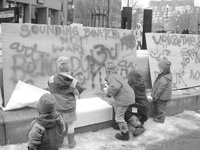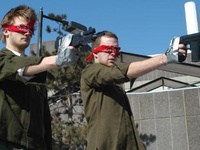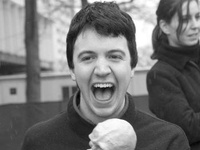
Anti-war puppeteer joins a growing, visible community of undergraduate artists working to entertain and engage the public on issues surrounding the war.
In the studio of Nancy C. Selvage, director of the ceramics program at the Office for the Arts, a sculpture begins to take the shape of an Iraqi territory—one which she thinks resembles the silhouette of a tank going down a hill.
Selvage’s work exemplifies how the war in Iraq—long a topic of political debate—is becoming a promiment theme of artistic expression.
“The effect of this war and the imagery of this war definitely permeates into our work, whether it happens consciously or not,” Selvage says.
In the weeks leading up to the war, poets held teach-ins at Harvard, theater groups performed their pleas for peace and hundreds waved handmade signs in a Harvard Initiative for Peace and Justice (HIPJ)-sponsored walkout.
But with troops in Baghdad, anti-war polemic can seem futile. While images of the war dominate the airwaves, Harvard artists have begun to explore individual suffering and violence in Iraq. And they say their art might open up the dialogue about both sides’ perspectives in the war.
The styles of their protest art are still taking shape, lacking the forms of Dadism or the lyrics of Bob Dylan, and most students have never lived through the reality of war.
Yet anti-war sentiment still filters through the artistic community, both on campus and nationally.
As celebrities speak out at award ceremonies, concerts and poetry readings, Harvard has reacted in its own way. With a relatively small visual studies program, much of the protest art has centered around text and theater.
Students hold improvisational open-mics and political stagings, and artists have put up soundboards—all in the hopes of opening dialogue about world affairs, they say.
According to Adams House photography tutor Lisa L. Gordon, people involved in these movements hope to avoid the “sloganeering” of simplisic political art.
“I feel that political art can be very easy,” said Gordon, who is organizing a one-night show about homeland security in the Adams House ArtSpace this month. “We are trying to offer inroads beyond that. We are opening the forum to people of all political beliefs.”
Inevitably, U.S. military intervention abroad will draw comparisons to Vietnam—but it seems that the artistic reaction to this war remains far from the charged days of ’60s and ’70s, when artists stated often dogmatic opinions through the canvas and the microphone.
With the war still relatively new, today’s artists have not quite established a cohesive movement—but they say that their work provides an alternative forum for discussion.
Doing Their Part
Two young men dressed in army fatigues stand on the rocks in front the Science Center. They have guns taped to their hands. Blindfolded, they point their weapons across the cement path at a group, clad all in white, who are holding signs.
Read more in Arts
Season Opens with World Premiere















